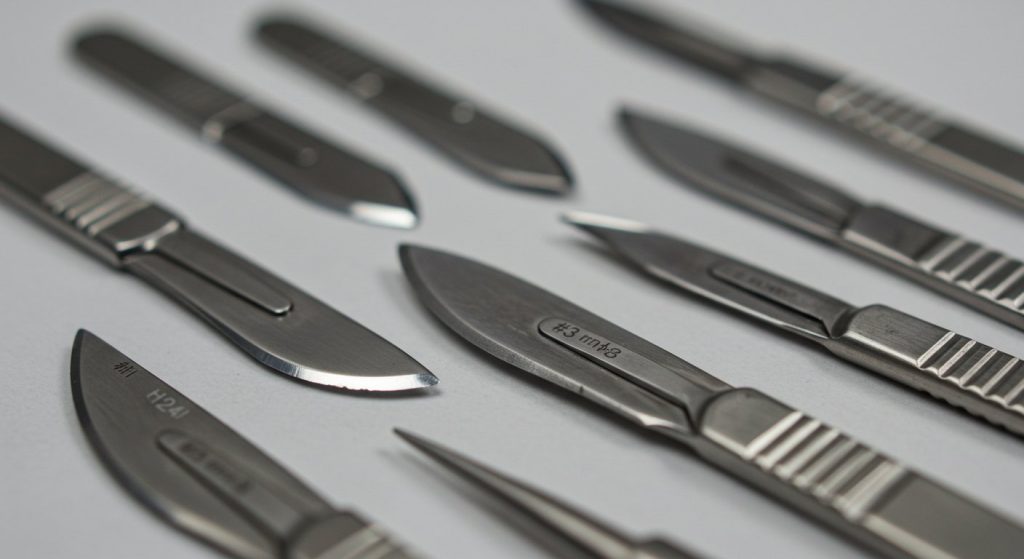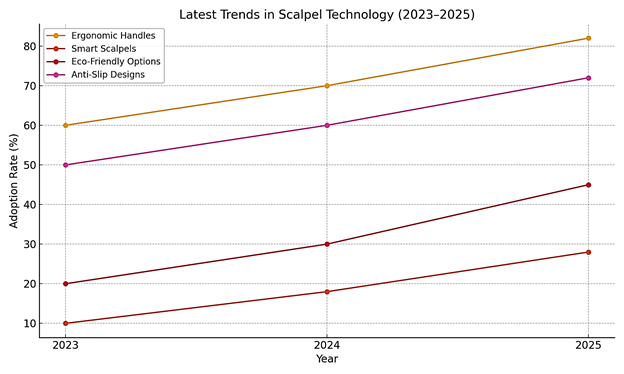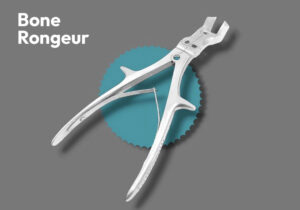The art of surgery cannot be mentioned without the discussion of the instrument scalpel. These tools, which are designed carefully, contribute significantly to the accuracy of medical procedures and the prevention of tissue trauma. The process of selecting the appropriate types of surgical scalpels is the first, and very important, step that is directly related to the success of the procedure and patient safety. This encyclopedic article takes a look at the fascinating world of surgical scalpels, their application, and the current technology in the area of scalpel usage.
What Is a Surgical Scalpel?
A surgical scalpel is a device made from a short blade that has a finely sharpened cutting edge that is used by surgeons to make precise cuts in surgeries. Its main function is to allow surgeons to do a very accurate, turnover value cut with the least damage to tissue conditions. The surgical scalpels have been through considerable evolution, from the primitive knives to sophisticated instruments for specific surgeries with precision application.
Scalpel Anatomy: The Right Blade Can Make All the Difference
In order to know the right tool to use for each task, an impression of the anatomy of scalped is very important. A scalpel typically consists of three main parts:
- Blade: The sharp side of the blade, which comes in different shapes and sizes
- Handle: The handle part, where the doctor holds and has control whole instrument
- Locking mechanism: For models with detachable blades, the mechanism for secure attachment
Doctors are able to select between disposable and reusable scalpel. Disposable scalpel applications include the elimination of cross-contamination and the use of the scalpel during only one procedure to minimize the risk of contamination. Reusable scalpels are the best long-term solution because they can be sterilized after each use, but the implementation of this practice must be very careful.

Main Types of surgical Scalpel Blades and Their Uses
No. 10 Blade
This type of blade has the curved edge, which makes it suitable for a large skin incision and is mostly used in the general surgical and autopsy procedures.
No. 11 Blade
Since it is a beveled triangular shape with a very sharp point, this blade is ideally suited for the insertion of the chest tube drain, the drainage of the abscess, etc.
No. 12 Blade
The fact that this blade has a hook design gives it the required accuracy to be used in the ENT and dental surgeries.
No. 15 Blade
The little curved blade is excellent for the very short and delicate incisions which is a distinct characteristic of the blade and hence it is one of them that has become quite popular in the pediatric and nasal surgeries.
No. 20 Series Blades (20, 21, 22)
These comparatively large-eared blades are acceptable only for orthopedic and abdominal surgeries where large incisions are demanded.
Latest Trends in Scalpel Technology (2023–2025)
The instrument category is continually being worked on in many ways. The following trends merit close attention:
- Ergonomic handles that are comfortable to use and eco-friendly.
- Artificial intelligence-powered scalpels that can help surgeons guide their incisions.
- Biodegradable surgical products that protect the environment from pollution.
These are new advancements aiming at making surgeries more precise and less polluting practices.

Different Surgical Fields and Different Types of Scalpels
General Surgery
In the course of general surgery, pathophysiology, diagnostics, treatment in the case of any pathology surgeons are often able to select from the versatile knives No. 10 and No. 22.
Cardiovascular
A lot of vascular interventions like ANGIO-XPLOR multislice computed tomography angiography and MRI are performed using No. 11 and No. 15 blades which allow cutting the vessels precisely and quickly.
ENT & Dental
ENT and the dental specialists have the curved No. 12 blade to allow reaching the tissues which are difficult to get into and the tight areas respectively.
Plastic Surgery
The No. 15 blade that produces attractive cuts is chosen by plastic surgeons due to its commendable performance in various surgeries.
Orthopedic
The range of the No. 20 and No. 22 blade is usually applied in orthopedic procedures for deeply making or firming up the incision through the very resistant tissues.
Neurosurgery
The practitioners, including neurosurgeons, depend onthe miniature blade size to acclimate the cuts with perfection and safe precision with minimal tissue disruption.
Material Matters: Blade Composition & Why It Counts
The choice of material in producing surgical scalpels plays a crucial role in their performance. The most frequently used modes of a surgical scalpel inspire:
- Stainless Steel: Demonstrates resistance to corrosion and stays sharp for an extended period.
- Carbon Steel: It goes without saying that this type is excessively sharp but it is also subject to rust due to oxidation.
- Ceramic Ones: This material is long-lasting but very brittle and less strong than metal.
Each material brings different benefits relating to how sharp they remain, corroding, and the cost. In the USA, apart from other options, stainless steel has been the most popular choice thanks to the fact that it is a good compromise between durability and the performance they give.
Sterilization & Safety Considerations are most Important
Scalpels are handled very responsibly strict standards should prevent infections and injuries. The basic norms should be remembered and followed here:
- Correct compliance with the scheduler protocols that follow the desired instructions.
- The proper disposal of the used blades, at the same time very crucial for blade and disposable scalpel uses.
- Compliance with OSHA sharps safety standards that are according to the experts.
The healthcare establishments critically meet the protective measures to be safe for the patients and the staff.
Top Scalpel Brands Surgeons Trust in the USA
A few manufacturers have won the confidence of physicians in the United States with the types of surgical scalpel names. When shopping for surgical instruments, it is recommended to check for the following:
- Stainless steel of strict quality that is also approved by the ISO certification organization.
- Also, it must have the CE mark on it that shows the item is properly allowed to be brought in.
- The blade should have FDA approval that guarantees that the item meets the necessary quality and safety standards.
The certificates are a guarantee that the goods are of great quality, the production is well organized, and safety is in place.
Conclusion: Precision Starts with the Right Scalpel at Wrangler
The choice of a suitable scalpel is the main thing in getting perfect surgery. This includes picking the best scalpel for dermaplaning to other special-cut blades that have very complex procedures which each one serves as a particular tool. A plethora of surgeons’ instruments is now available, thanks to the technological advancement which has also brought benefits to practitioners and patients.
Which surgical instrument do you think would be the best choice for your surgical application? If you still do not know which types of surgical scalpels suits your surgical needs, Wrangler is here to help you just call us for a free consultation or request a custom quote from our company and get started.
FAQs
1. What is the most common type of surgical scalpel?
The No. 10 blade is among the sorts of surgical scalpels a few years ago which was a frequently utilized one. A more specific way of surgery is executed by the blade due to its feature of the curved cutting edge, this the reason why it is common in operations like general surgery, in a large skin incision.
2. How often should surgical scalpels be replaced?
In the case of the reusable, blade replacement should be done in each and every procedure. Disposable scalpels are designed to be used only once during a procedure, and at this point, the whole thing should be put on the right side of the medical waste disposal directives.
3. What is the difference between a scalpel and a surgical knife?
Both are often termed the same, almost like they are the same thing. However, in the case of a scalpel, it is moreof a detachable blade which is a more distinguishing mark of the term precision instruments than knives with a fixed blade. Besides the alternative of switching back and forth, the fixed blade may be as brief as the knife.
4. Are there specific scalpels for cosmetic procedures?
Undoubtedly, some kinds of aesthetic surgery needed very special scalpels to be employed. For instance, the most popular surgical device for dermaplaning is a No. 10 or No. 14 blade, which is perfect for the smooth and gentle removal of the skin.
5. How are scalpel blades sterilized?
In most cases, surgical dermaplaning blade sterilization is an autoclave process where reusable blades are made so that they work with the autoclave machines, which, in turn, make up the autoclave process with high-pressure steam.



